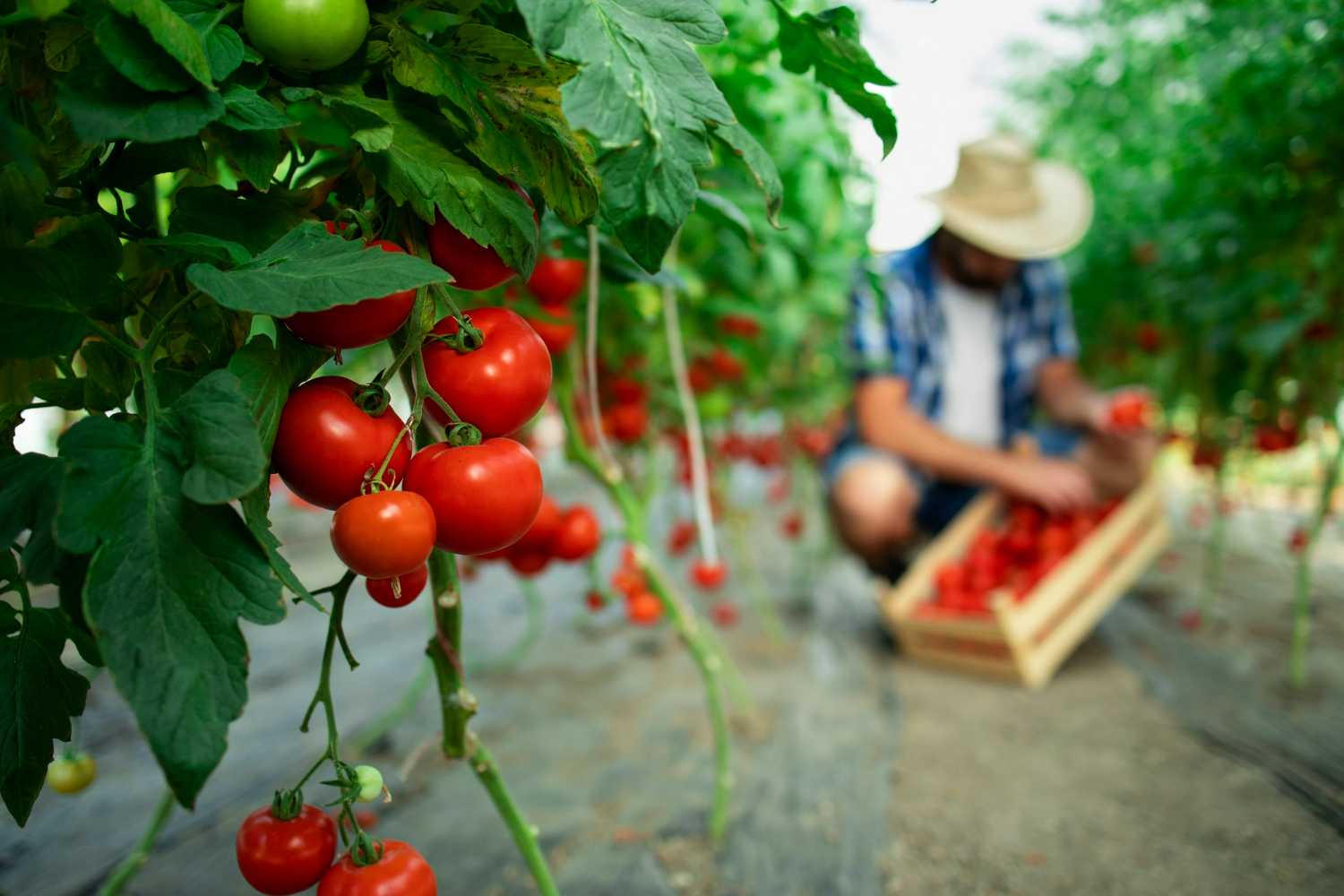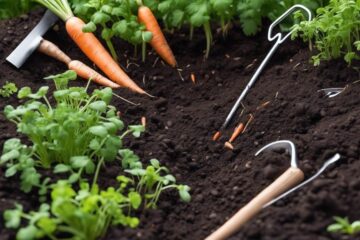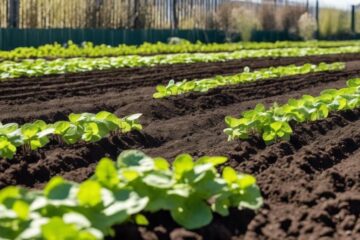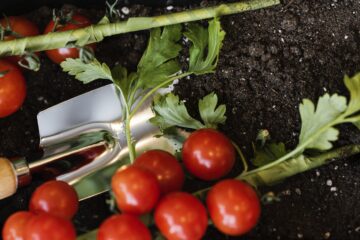Ever wondered if trimming your tomato plants could truly make a difference in the size and quality of your harvest? Understanding the nuances of trimming techniques and how they can impact your plants is important for maximizing their potential.
As you explore the intricacies of trimming determinate versus indeterminate tomatoes, you’ll uncover tailored strategies that could be the key to revealing your tomato plants’ true productivity. Stay tuned to discover how these insights can revolutionize your gardening approach and lead you to a bountiful tomato harvest.
Understanding Tomato Plant Types
Understanding the distinction between determinate and indeterminate tomato plants is essential for maximizing your harvest potential. Tomato plants come in two main varieties: determinate and indeterminate.
Determinate varieties are perfect for smaller spaces or for those looking to harvest a large crop all at once. These plants grow to a predetermined size and produce all their fruit in a short period.
On the other hand, indeterminate varieties are favored for their continuous fruit production throughout the season. They keep growing based on environmental conditions, providing a prolonged harvest.
Pruning Techniques and Specific Times for Pruning Tomato Plants
Specific Pruning for Determinate Tomatoes
To guarantee healthy growth and peak fruit production for determinate tomatoes, focus on minimal pruning that supports their predetermined size and fruiting pattern. When pruning determinate tomato plants, prioritize the removal of suckers and shaded lower leaves to maintain plant vigor. These plants typically have two main stems, so make sure they’re well-supported for the best growth.
By removing excess foliage, you redirect energy away from unnecessary growth and towards fruit development. Additionally, regularly removing damaged or dead leaves will promote overall plant health and prevent disease spread.
Specific Pruning for Indeterminate Tomatoes
When tending to indeterminate tomatoes, focus on strategically pruning lower shoots to guarantee robust growth and prevent shading or ground contact. Indeterminate tomatoes, unlike determinate varieties, have a continuous growth pattern, requiring more attention to pruning.
By aggressively removing vigorous suckers from the lower part of the plant, you promote strong upward growth and better airflow, reducing the risk of diseases. This strategic pruning also directs the plant’s energy towards fruit production, enhancing the overall yield.
Regularly inspect your indeterminate tomatoes and prune as needed to maintain an open canopy and prevent overcrowding. Remember to remove flower buds approaching the end of the season to guarantee the plant focuses on ripening existing fruits.
Early Spring Pruning Tomato
Pruning techniques play a pivotal role in optimizing fruit production and overall plant health in tomato plants. Proper pruning redirects energy towards fruit development, leading to higher yields. By removing suckers, you make certain that the plant focuses its resources on producing quality tomatoes.
Additionally, pruning helps improve airflow within the plant, reducing the risk of diseases that thrive in moist environments. Managing the growth of your tomato plants through strategic pruning not only enhances fruit quality but also promotes better overall plant health.
When preparing for the gardening season, early spring pruning of tomato plants is essential for promoting healthy growth and maximizing fruit production. Pruning in early spring helps remove winter damage and dead growth from the plants. It’s crucial to prune before new growth emerges to avoid cutting off potential fruiting branches.
Removing excess foliage early on sets the stage for healthier plant development and increased fruit production. Additionally, early spring pruning allows for better air circulation and sunlight exposure as the plants begin to grow. This process is fundamental as it shapes the plant’s structure, laying the foundation for a productive growing season ahead.
After Transplanting
After transplanting tomato plants, allow them time to establish roots and acclimate to their new surroundings before considering any pruning tasks. Pruning immediately after transplanting can stress the plants, impacting their growth. It’s best to wait about 1-2 weeks post-transplant to prune the tomato plants, giving them the opportunity to recover from any shock they may have experienced during the transplantation process.
| Importance of Waiting to Prune After Transplanting |
|---|
| Helps plants recover from transplant shock |
| Allows plants to settle in and start growing |
| Ensures plants have the strength to handle pruning |
| Prevents stress on plants affecting growth |
Once Flowers Appear
Prune tomato plants once flowers emerge to redirect energy towards fruit production. By pruning at this stage, you optimize plant growth for larger and better quality tomatoes. Trimming excess foliage after flowering not only enhances airflow but also reduces the risk of diseases.
This strategic pruning ensures that your plants concentrate on developing and ripening fruits efficiently. Timing your pruning with the appearance of flowers is crucial for promoting healthy fruit development and achieving earlier ripening.
Mid-Summer Maintenance
In mid-summer, consider optimizing fruit production by pruning your tomato plants for enhanced vigor and focused energy on developing fruits. To make the most out of your tomato plants during this crucial period, remember the following tips:
- Pruning Tomato Plants: Trim back excessive growth to redirect the plant’s energy towards fruit production.
- Mid-Summer Maintenance: Regularly check for any signs of disease or pest infestation to address issues promptly.
- Enhancing Fruit Production: Remove suckers and non-fruiting branches to promote larger, healthier tomatoes.
- Improving Airflow: Prune overcrowded areas to increase airflow around the plants, reducing the risk of fungal diseases and promoting overall plant health.
Before Excessive Growth
To maintain a balanced plant structure and optimize growth, consider initiating pruning of your tomato plants before they experience excessive growth. Pruning before excessive growth sets in helps promote better air circulation and sunlight exposure, crucial for the plants’ development.
By preemptive pruning, you can prevent overcrowding within the plant, which can hinder fruit development later on. Timing your pruning activities before excessive growth occurs ensures that you can manage your plants more easily and effectively.
Moreover, pruning at the right time can reduce the need for heavy pruning later in the season. So, keep an eye on your tomato plants and prune them at the appropriate time to set them up for success.
Pre-Fruit Setting Stage
During the pre-fruit setting stage of tomato plant growth, redirecting plant energy towards fruit production is crucial for optimal harvest outcomes. Here are some key points to consider:
- Pruning tomatoes at this stage helps redirect plant energy towards fruit production.
- Early pruning leads to larger and healthier fruit development in the upcoming growing season.
- Removing excess foliage before fruit set improves air circulation and sunlight exposure.
- It’s recommended to prune when the plant is around 12-18 inches tall for the best results.
Practicing proper pruning techniques during the pre-fruit setting stage sets the stage for a successful harvest by managing plant growth and focusing on fruit development.
Post-Harvest Clean-Up
After successfully harvesting your tomatoes, the next essential step is post-harvest clean-up to maintain a healthy growing environment for future crops.
To prevent disease spread, prune back any remaining foliage or branches. Remove all dead or decaying plant material to eliminate potential sources of infection. Clear out debris and fallen leaves around the tomato plants, reducing the risk of fungal infections. Properly dispose of all plant debris to prevent the spread of pathogens to other garden plants.
Post-harvest clean-up plays a vital role in promoting plant health and preventing overwintering pests. By following these steps, you can create a clean and disease-free environment that will benefit your future tomato crops.
End of Growing Season
As the growing season comes to a close, consider pruning your tomato plants to remove any diseased or damaged foliage. This practice helps the plant prepare for dormancy and the upcoming winter. By pruning at the end of the season, you can prevent pests and diseases from overwintering in the plant. Additionally, trimming before the frost sets in can protect the plant from damage, ensuring a healthier start for the next growing season.
- Prune tomato plants to remove diseased or damaged foliage.
- Trimming at the end of the season helps prepare the plant for dormancy and winter.
- Removing excess foliage can prevent overwintering of pests and diseases.
- Pruning before frost hits can help protect the plant from damage.
Winter Pruning Preparation
Prepare your tomato plants for winter by evaluating their health and addressing any disease issues through winter pruning. It is crucial to prune determinate varieties to remove any diseased or damaged branches before winter sets in. By pruning away these issues now, you can reduce the risk of infection and promote overall plant vigor. This preparation not only sets the stage for healthy regrowth in the spring but also improves airflow and sunlight exposure for new growth. Enhancing air circulation around your plants is key to preventing disease buildup during the winter months. Follow the table below for a quick guide on winter pruning preparation:
| Winter Pruning Preparation Tips |
|---|
| Prune determinate varieties |
| Remove diseased or damaged branches |
| Enhance air circulation |
Routine Maintenance Schedule
To maintain the health and productivity of your tomato plants, establish a routine maintenance schedule that includes regular pruning every two weeks starting when flowers first appear. This practice promotes optimal growth, redirects energy towards fruit production, and maintains plant vigor. Timing is crucial, typically beginning in mid-June to mid-July for best results. Ensure to prune on dry plants to prevent potential issues like infections.
- Regular pruning every two weeks starting when flowers first appear
- Redirect energy towards fruit production
- Timing is crucial, typically mid-June to mid-July
- Prune on dry plants to prevent infections.
Tips for Successful Tomato Plant Pruning
For optimal results in pruning your tomato plants, consider the specific needs of each variety to ensure healthy growth and abundant fruit production. Here are some essential tips to help you successfully prune your tomatoes:
- Eliminate Suckers: Regularly inspect your tomato plants and eliminate any suckers that develop in the leaf axils. This practice directs the plant’s energy towards fruit production rather than excessive foliage growth.
- Prioritize Fruit-Bearing Branches: When pruning, focus on maintaining a balance between foliage and fruit-bearing branches. By selectively trimming excess foliage, you can improve air circulation around the plant, reducing the risk of diseases.
- Maintain Adequate Air Circulation: Adequate air circulation is essential for healthy tomato plants. Pruning helps create space between branches, allowing for better airflow and reducing humidity levels, which can prevent fungal infections and promote overall plant vigor.
Frequently Asked Questions
When Should You Prune Tomato Plants?
When should you prune tomato plants? Start pruning when flowers appear for better fruit growth. Trim from mid-June to mid-July for best results. Keep up every two weeks until fruits ripen. Morning, dry plants are ideal for pruning.
How Do You Know Which Branches to Prune on a Tomato Plant?
You know which branches to prune on a tomato plant by checking for ground contact, crossing branches, shading, yellowing leaves, disease signs, overcrowding, or density. Trim to prevent disease spread, damage, and promote healthy growth.
How Do I Trim My Tomato Plants to Produce More Fruit?
To trim your tomato plants for more fruit, focus on removing suckers and excess growth. Use clean shears to pinch off suckers at the Y-junction. Prune regularly to direct energy towards fruit production and improve quality.
How Do You Prune Tomatoes to Increase Yield?
To increase yield when pruning tomatoes, focus on removing suckers and excess foliage. Redirect plant energy towards fruit production by following proper techniques. By pruning at the right times and using correct methods, you’ll maximize your plant’s potential.
Conclusion
You’ve learned the best times to prune tomato plants, but did you know that pruning can increase fruit production by up to 20%?
By following a routine maintenance schedule and pruning at the right times, you can ensure healthy and productive tomato plants all season long.
So grab your pruning shears and get ready to boost your tomato harvest!
Check our other tips for growing vegetables!





